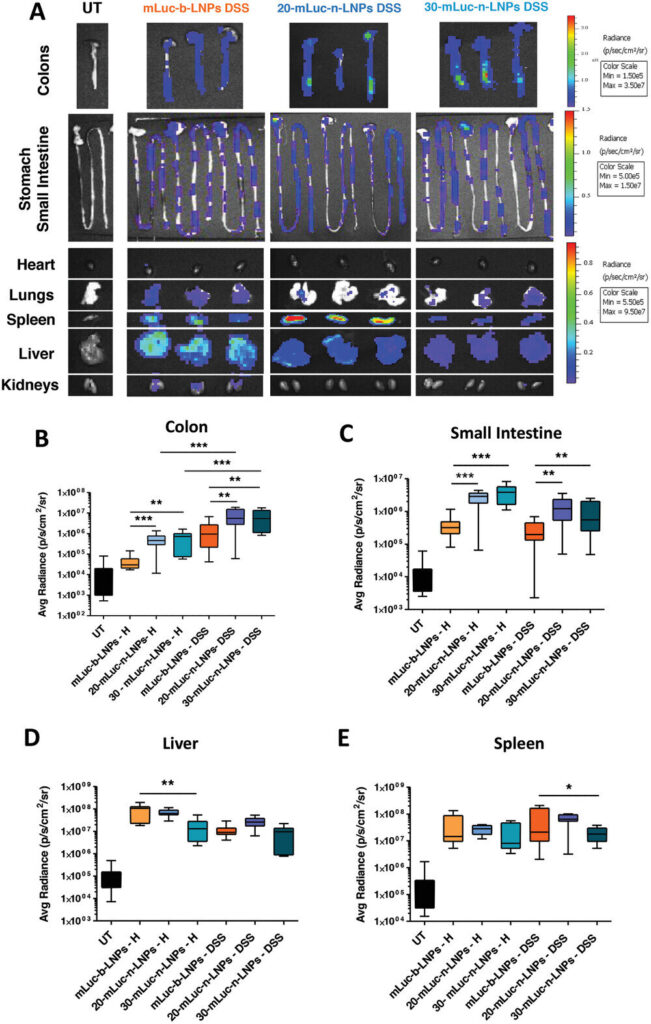Researchers at Tel Aviv University have achieved a breakthrough in drug delivery: they have successfully transported lipid nanoparticles encapsulating messenger RNA (mRNA) to the immune system of the small and large intestines—bypassing the liver upon systemic administration. By simply altering the composition of the nanoparticles, the researchers demonstrated that mRNA-based drugs can be directed straight to target cells, avoiding the liver.
The Tel Aviv University study was led by post-doctoral fellow Dr. Riccardo Rampado together with Vice President for R&D Prof. Dan Peer, a pioneer in the development of mRNA therapeutics and Director of the Laboratory of Precision Nano-Medicine at the Shmunis School of Biomedical and Cancer Research. The study was published on the cover of the journal Advanced Science.
“Everything injected into the bloodstream eventually ends up in the liver—that’s just how our anatomy works,” explains Prof. Peer. “This poses two challenges. First, drugs intended to target specific cells in particular organs may be toxic to the liver. Second, we don’t want drugs to get ‘stuck’ in the liver.
“Ideally, the drug would reach the target organ first, and any remnants would then break down in the liver. We discovered that altering the proportions of lipids comprising the nanoparticles determines their destination in the bloodstream. This is a general phenomenon, meaning it works regardless of the specific lipids, which makes this a significant breakthrough.”
To demonstrate the concept, Prof. Peer and his team encoded the anti-inflammatory protein interleukin-10 into mRNA, encapsulated it in lipid nanoparticles with a composition different from those typically used (such as in mRNA COVID-19 vaccines), and successfully delivered it to the intestines of animal models with Crohn’s disease and colitis via intravenous injection.
“Not only were we able to deliver an mRNA-based anti-inflammatory drug directly to the inflamed intestine and improve all markers of colitis and Crohn’s disease, but we also transformed the immune cells in the intestine into factories for producing the anti-inflammatory interleukin-10,” Prof. Peer explains.
“But this is just a proof of concept study. By tweaking the nanoparticle composition, we could deliver other RNA-based drugs to different organs. There’s a saying in American English: ‘It’s all in the formulation.’ That’s exactly what this is about.”
In general, lipid-based drugs are encased in synthetic lipid nanoparticles, which mimic biological membranes. One of these lipids is phospholipid named phosphatidylcholine, a component found in all biological membranes.
In vaccines like the COVID-19 vaccine, the mRNA is encapsulated in lipid particles containing about 10% of this phospholipid. Prof. Peer and his team increased the phospholipid ratio to 30% and demonstrated that this adjustment caused the particles to float through the bloodstream like oil on water.
“That’s the whole trick,” Prof. Peer concludes. “We adjusted the lipid composition and found that at 30% phospholipid, the drug is directed straight to the intestine. Of course, this wasn’t a blind trial-and-error approach. We understand the mechanism, at least partially, and recognize that this ratio more closely resembles a natural biological membrane, which intestinal cells are better suited to absorb.
“Now, we are exploring further adjustments to target the pancreas and other organs that can only be reached by fine-tuning the lipid nanoparticle composition. This direct delivery method for mRNA drugs opens up broad possibilities for developing new and more precise therapies than ever before.”


